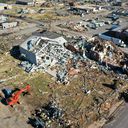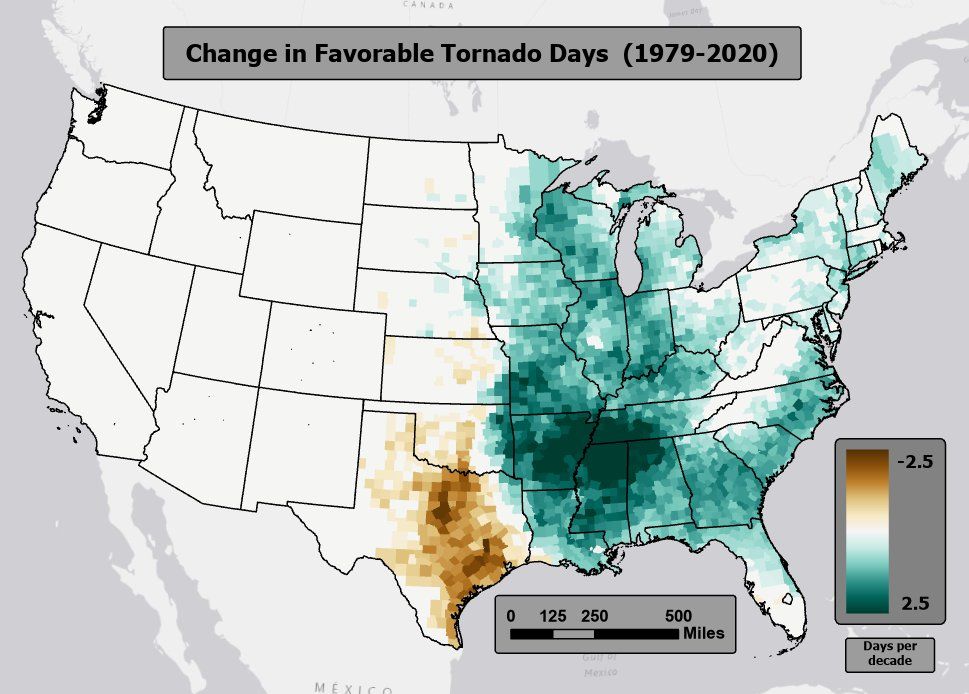Tornado outbreak offers a grim climate warning

The deadly tornado rampage across a six-state region Friday night into Saturday bears the hallmarks of climate change-related trends that scientists have been studying more closely in recent years.
Why it matters: Climate change is altering the environment in which tornadoes form in ways that raise the odds of sparking dangerous severe weather outbreaks across the South and Mid-South, particularly during the fall and winter when the jet stream dives toward the region.
- The weekend outbreak illustrates an extreme scenario of what can happen when all the ingredients that cause devastating tornadoes come together in spades. These include a record warm, humid air mass and powerful winds that shift in speed/direction with height, which is known as wind shear.
- But the attribution of individual outbreaks, and to some extent overall trends, is trickier with tornadoes, researchers say, since they are small-scale phenomena when compared to other extreme events such as heat waves.
- Increasingly, though, climate change clues are emerging, and they're not encouraging.
- Tornado risk is increasing in the Mid-South and Southeast compared to the Plains states, and tornado occurrence is becoming more variable from year to year. A new study shows that as temperatures increase, so do key ingredients for severe weather outbreaks.
The big picture: The latest outbreak stands apart from anything previously seen during the month of December. In some respects, what occurred was worse than anything that came before it, no matter what month you look at.
- The supercell thunderstorm that tracked for more than 250 miles from Arkansas into Kentucky spawned either a single tornado or family of twisters that may have broken the record for the longest tornado path length in U.S. history.
- That storm, feasting off an air mass that more closely resembled April or May than December, catapulted debris 30,000 feet into the air. Some rained down from the sky more than 100 miles away.
- The storms were the deadliest December tornado outbreak on record. If the Mayfield tornado is rated as an EF-5 on the tornado damage scale, it will be one of just three such high-end twisters to occur in December.
Context: Victor Gensini, a meteorology professor at Northern Illinois University, said he woke up Friday morning to a weather map that looked more like spring than December.
- A record warm air mass was in place across the Southeast and humidity was high. Both act as fuel for severe weather.
- The warmth and humidity were boosted by strong winds blowing north from the unusually warm waters of the Gulf of Mexico. Gulf waters are running several degrees above average for this time of year.
In Memphis, Tennessee, the high on Friday was 80°F, a record high and 25°F above average for the date. The heat played a critical role in fueling the disaster.
- So too did powerful mid and upper-level winds that were blowing in different directions with height, causing thunderstorms to spin like a top.
- Climate studies show that shear may decrease some as the world warms, but that warm, moist and unstable environments will become more common. It's when these ingredients overlap that you get a record-shattering event, and for tornadoes, this occurs most frequently in the Mid-South and South during fall and winter.
- "The shear is almost always there in the cool season, it's the instability that you don’t have," Gensini said.

Between the lines: Tornado trends, such as a shift in their geographic distribution, and increased variability from year to year, are what scientists expect to see in a warming world, according to Gensini.
- Projections show an increase in major outbreaks in the mid-South and Southeast in particular, he said.
- Harold Brooks, senior scientist at the National Severe Storms Laboratory in Oklahoma, who also studies tornadoes and climate change, told Axios that the increase in days with favorable conditions for tornadoes in the South and Southeast already stands out as a climate-related signal.
- Gensini compared tornado attribution today to the steroids era of baseball. Pinning an individual home run on steroid use is difficult, he said, but in the aggregate the trends are evident.
- He said the right question to ask now may be whether anyone can prove that climate change is not influencing tornadoes and the environment in which they form.
What's next: The heartbreaking devastation that played out over the weekend may be a preview of what's to come as favorable conditions for strong Southern tornadoes overlap more with sprawling communities that lack the strict building codes present in some historically tornado-prone states.
- "What we’re going to see is more of these disasters," Gensini said.